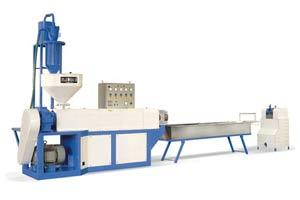
|
Ningbo Jinyi Precision Machinery Co., Ltd.
|
Gold Index: 25514
You are here: home > Study Room > Extrusion Instability
Product (264)
-
Screw Barrel
(242)
- Single Screw Barrel (137)
- Injection Screw Barrel (29)
- Extrusion Screw Barrel (13)
- Bimetallic Screw Barrel (13)
- Twin Screw Barrel (18)
- Screw Barrel Accessory (21)
- Plastics Screw Barrel (8)
- Recycling Screw Barrel (2)
- Blowing Film Screw Barrel (1)
- Tie Bar (4)
- Reduction Gearbox (4)
- Auxiliary Machinery (14)
Trade Show (15)
Equipment (13)
Certificate (5)
Develop & Customers (1)
Study Room (17)
Credit Report
Products Index
Study Room
Extrusion Instability

1) Unstable high oscillation frequency that is faster than screw RPM
* Symptom: Unstable die flow due to melt fracture / shark skin / draw resonance
* Reasons: Motor problems or lack of homogeneity of melts
2) Unstable oscillation frequency at similar speed with screw RPM
* Reasons: Pressure difference between pushing and pushed side of hopper flight
Reasons for pressure difference
- Screw diameter is big
- Viscosity of melts is high
- Screw rotation is fast
- Helix angle or pitch is big
- Depth of feeding section is shallow
3) Unstable low oscillation frequency at 1/5~1/10 of screw RPM
* Reasons: Destruction of solid bed
* Causes of solid bed destruction
- At some point during melting (in most cases, when 30~70% of melting is completed), destruction of solid bed occurs and normal melt status is changed to unstable status. This is attributable to the fact that melt film is formed on screw side.
- To suppress the formation of melt film on screw side, it will be desirable to cool screw or to use barrier screw
- To solve the instability and resolve related problems from the destruction of solid bed, it will be better to make the destruction point far away from the tip of screw, which means that melting is finished as quickly as possible thereby expanding the gap between melting and screw tip. Bringing up the head pressure will be most effective and also increasing temperature at hopper side of extruder will be helpful. Higher head pressure will speed up screw rotation at the same extrusion output, and increase of RPM will bring up the speed of melting. Also, increasing temperature is to speed up melting.
4) Very slow changes with small number of oscillation frequency
* Reasons: Poor temperature control, changes in processing conditions (room temperature, relative humidity) and changes in external factors attributable to pressure and hydraulic pressure changes.
5) Random changes
- Design problems in material feeding section or abnormal supply
- Screw depth of feeding section is not enough
- Extrusion output and its stability are closely related to hopper fill factor
- In case hopper is filled to a certain extent, the maximum temperature change is 7¡ÆC as materials are supplied on a regular basis.
Pre Page:
Blowing Film Products Trouble Shooting
Next Page:
Reasons for Extrusion Instability



